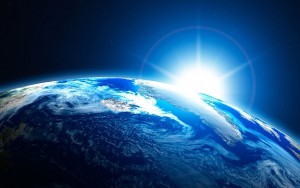Question:
The eight planets rotate on their own axes at different speeds. Generally, the greater the mass, the faster the speed. Jupiter, the largest planet, has also the fastest speed of rotation of 9 hours, 50 minutes. Mars, the smallest of the outer planets, rotates in 24 hours 37 minutes. The Earth is about 10 times as massive as Mars, yet it rotates in about the same time: 24 hours. Why does the Earth rotate so slowly?
Answer:
The seemingly leisurely rotation of Earth, despite its significant mass advantage over Mars, can be attributed to the intricate dance it performs with its celestial companion, the Moon. The presence of the Moon profoundly influences Earth’s rotation, slowing it down through the fascinating phenomenon of tidal effects.
In the Absence of the Moon:
- Hypothetical Rotation Speed:
- Speed without Moon’s Influence: In the absence of the Moon, Earth’s rotational speed would be a brisk 15.5 hours. This hypothetical scenario underscores the profound impact that the Moon has on Earth’s rotation.
Tidal Effects and the Moon’s Influence:
- Reciprocal Gravitational Forces:
- Tidal Dynamics: The gravitational relationship between Earth and the Moon is reciprocal. While Earth is influenced by the Moon’s gravity, the Moon is equally affected by Earth’s gravitational force. However, Earth’s gravitational pull is approximately 81 times stronger than the Moon’s.
- Slowing Down Earth’s Rotation:
- Tidal Friction: As the Moon exerts its gravitational force on Earth, tidal friction comes into play. This friction acts as a brake on Earth’s rotation, gradually slowing it down over time.
Moon’s Synchronous Rotation:
- Remarkable Synchronization:
- Synchronous Rotation: The Moon’s rotation has been significantly affected by Earth’s gravity. The Moon’s rotation has slowed to an extent that it takes approximately 27.321582 days to complete one full turn, coincidentally matching its orbital period around Earth. This synchronization results in a phenomenon known as synchronous rotation, where one side of the Moon always faces the Earth.
Earth’s Slowed Rotation:
- Reciprocal Impact:
- Earth’s Reduced Spin: The process of tidal friction not only affects the Moon but also imparts its influence on Earth’s rotation. Earth’s rotation has been gradually slowed down by the tidal effects of the Moon’s gravity, resulting in a rotation period of approximately 24 hours.
Conclusion:
The seemingly sluggish rotation of Earth, despite its considerable mass, is a testament to the intricate gravitational dance it shares with the Moon. Tidal effects, driven by the reciprocal gravitational forces between Earth and its celestial companion, have significantly influenced the rotational dynamics of both celestial bodies. The synchronous rotation of the Moon and the moderated rotation speed of Earth underscore the fascinating interplay of celestial forces that shape the dynamics of our planetary system.
